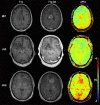Assessment of Amide proton transfer weighted (APTw) MRI for pre-surgical prediction of final diagnosis in gliomas
- PMID: 33373375
- PMCID: PMC7771875
- DOI: 10.1371/journal.pone.0244003
Assessment of Amide proton transfer weighted (APTw) MRI for pre-surgical prediction of final diagnosis in gliomas
Erratum in
-
Correction: Assessment of Amide proton transfer weighted (APTw) MRI for pre-surgical prediction of final diagnosis in gliomas.PLoS One. 2021 Apr 8;16(4):e0250189. doi: 10.1371/journal.pone.0250189. eCollection 2021. PLoS One. 2021. PMID: 33831103 Free PMC article.
Abstract
Purpose: Radiological assessment of primary brain neoplasms, both high (HGG) and low grade tumors (LGG), based on contrast-enhancement alone can be inaccurate. We evaluated the radiological value of amide proton transfer weighted (APTw) MRI as an imaging complement for pre-surgical radiological diagnosis of brain tumors.
Methods: Twenty-six patients were evaluated prospectively; (22 males, 4 females, mean age 55 years, range 26-76 years) underwent MRI at 3T using T1-MPRAGE pre- and post-contrast administration, conventional T2w, FLAIR, and APTw imaging pre-surgically for suspected primary/secondary brain tumor. Assessment of the additional value of APTw imaging compared to conventional MRI for correct pre-surgical brain tumor diagnosis. The initial radiological pre-operative diagnosis was based on the conventional contrast-enhanced MR images. The range, minimum, maximum, and mean APTw signals were evaluated. Conventional normality testing was performed; with boxplots/outliers/skewness/kurtosis and a Shapiro-Wilk's test. Mann-Whitney U for analysis of significance for mean/max/min and range APTw signal. A logistic regression model was constructed for mean, max, range and Receiver Operating Characteristic (ROC) curves calculated for individual and combined APTw signals.
Results: Conventional radiological diagnosis prior to surgery/biopsy was HGG (8 patients), LGG (12 patients), and metastasis (6 patients). Using the mean and maximum: APTw signal would have changed the pre-operative evaluation the diagnosis in 8 of 22 patients (two LGGs excluded, two METs excluded). Using a cut off value of >2.0% for mean APTw signal integral, 4 of the 12 radiologically suspected LGG would have been diagnosed as high grade glioma, which was confirmed by histopathological diagnosis. APTw mean of >2.0% and max >2.48% outperformed four separate clinical radiological assessments of tumor type, P-values = .004 and = .002, respectively.
Conclusions: Using APTw-images as part of the daily clinical pre-operative radiological evaluation may improve diagnostic precision in differentiating LGGs from HGGs, with potential improvement of patient management and treatment.
Conflict of interest statement
PvZ acknowledges research support from Philips Healthcare, travel support from Philips Healthcare, paid lectures for Philips Healthcare. Also, APT technology is licensed to Philips Healthcare. The commercial vendor Siemens Healthcare provided support in the form of salaries for authors FT and BS, but did not have any additional role in the study. The specific roles of these authors are articulated in the ‘author contributions’ section. This does not alter our adherence to PLOS ONE policies on sharing data and materials.
Figures








Similar articles
-
Role of Amide Proton Transfer Weighted MRI in Predicting MGMTp Methylation Status, p53-Status, Ki-67 Index, IDH-Status, and ATRX Expression in WHO Grade 4 High Grade Glioma.Tomography. 2025 May 31;11(6):64. doi: 10.3390/tomography11060064. Tomography. 2025. PMID: 40560010 Free PMC article.
-
Differentiating the histologic grades of gliomas preoperatively using amide proton transfer-weighted (APTW) and intravoxel incoherent motion MRI.NMR Biomed. 2018 Jan;31(1):10.1002/nbm.3850. doi: 10.1002/nbm.3850. Epub 2017 Nov 3. NMR Biomed. 2018. PMID: 29098732 Free PMC article.
-
Molecular MRI differentiation between primary central nervous system lymphomas and high-grade gliomas using endogenous protein-based amide proton transfer MR imaging at 3 Tesla.Eur Radiol. 2016 Jan;26(1):64-71. doi: 10.1007/s00330-015-3805-1. Epub 2015 Apr 30. Eur Radiol. 2016. PMID: 25925361 Free PMC article.
-
Amide proton transfer-weighted MRI in distinguishing high- and low-grade gliomas: a systematic review and meta-analysis.Neuroradiology. 2019 May;61(5):525-534. doi: 10.1007/s00234-018-02152-2. Epub 2019 Jan 21. Neuroradiology. 2019. PMID: 30666352
-
The role of imaging in the management of adults with diffuse low grade glioma: A systematic review and evidence-based clinical practice guideline.J Neurooncol. 2015 Dec;125(3):457-79. doi: 10.1007/s11060-015-1908-9. Epub 2015 Nov 3. J Neurooncol. 2015. PMID: 26530262
Cited by
-
Review and consensus recommendations on clinical APT-weighted imaging approaches at 3T: Application to brain tumors.Magn Reson Med. 2022 Aug;88(2):546-574. doi: 10.1002/mrm.29241. Epub 2022 Apr 22. Magn Reson Med. 2022. PMID: 35452155 Free PMC article. Review.
-
3D APT and NOE CEST-MRI of healthy volunteers and patients with non-enhancing glioma at 3 T.MAGMA. 2022 Feb;35(1):63-73. doi: 10.1007/s10334-021-00996-z. Epub 2022 Jan 7. MAGMA. 2022. PMID: 34994858 Free PMC article.
-
Role of Amide Proton Transfer Weighted MRI in Predicting MGMTp Methylation Status, p53-Status, Ki-67 Index, IDH-Status, and ATRX Expression in WHO Grade 4 High Grade Glioma.Tomography. 2025 May 31;11(6):64. doi: 10.3390/tomography11060064. Tomography. 2025. PMID: 40560010 Free PMC article.
-
Advanced Diagnosis of Glioma by Using Emerging Magnetic Resonance Sequences.Front Oncol. 2021 Aug 5;11:694498. doi: 10.3389/fonc.2021.694498. eCollection 2021. Front Oncol. 2021. PMID: 34422648 Free PMC article. Review.
-
Novel non‑metal‑based contrast agents for MR imaging: Emerging approaches and clinical perspectives (Review).Int J Oncol. 2025 Aug;67(2):70. doi: 10.3892/ijo.2025.5776. Epub 2025 Jul 19. Int J Oncol. 2025. PMID: 40682851 Free PMC article. Review.
References
-
- Urhie O, Turner R, Lucke-Wold B, Radwan W, Ahn J, Gyure K, et al. Glioblastoma Survival Outcomes at a Tertiary Hospital in Appalachia: Factors Impacting the Survival of Patients Following Implementation of the Stupp Protocol. World Neurosurg. 2018. July;115:e59–66. 10.1016/j.wneu.2018.03.163 - DOI - PMC - PubMed
-
- Kondziolka D, Lunsford LD, Martinez AJ. Unreliability of contemporary neurodiagnostic imaging in evaluating suspected adult supratentorial (low-grade) astrocytoma. J Neurosurg. 2009. October;79(4):533–6. - PubMed
Publication types
MeSH terms
Grants and funding
LinkOut - more resources
Full Text Sources
Medical

